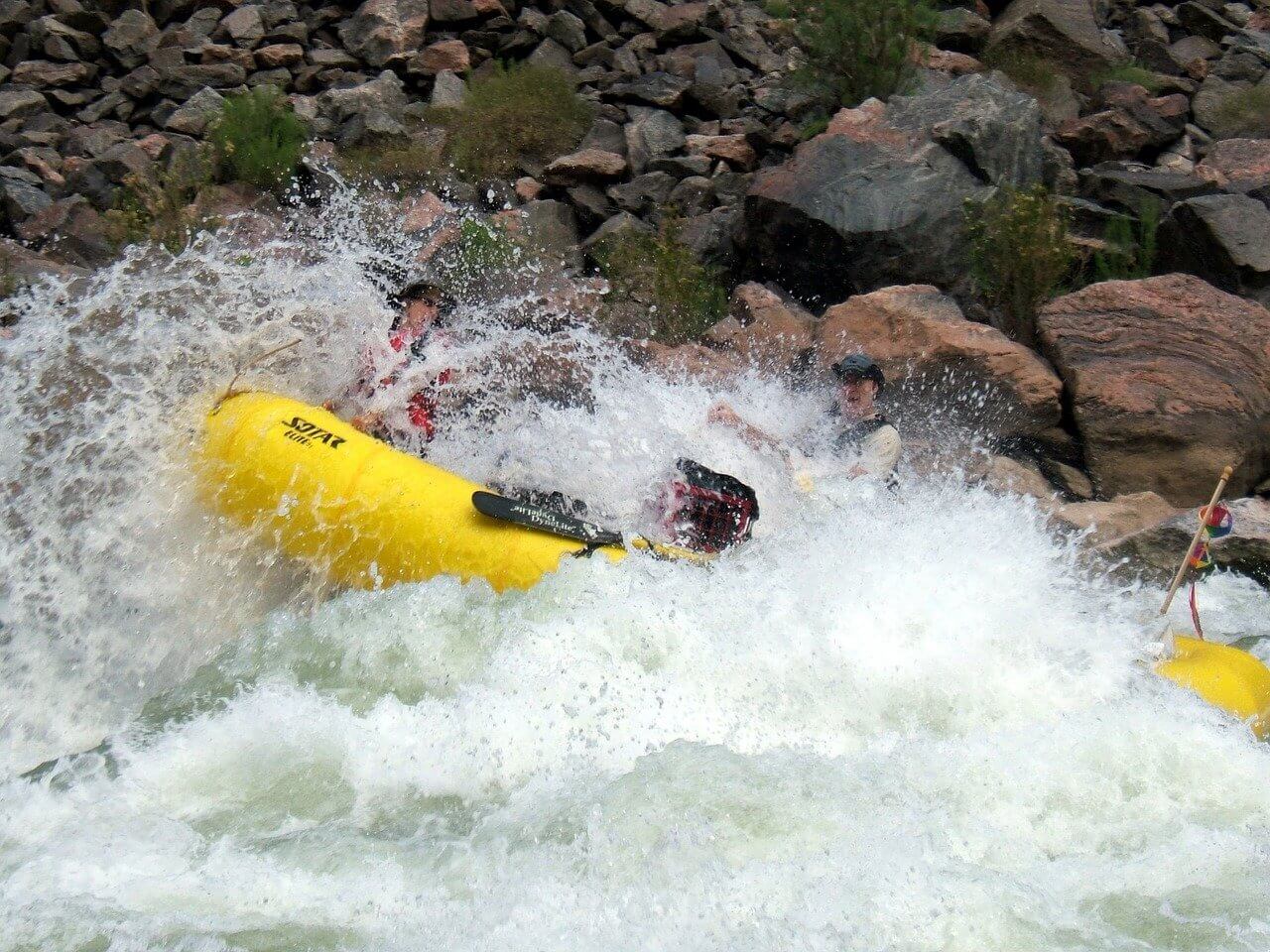The first question to be answered when considering white water rafting is, 'What happens if I fall out of the raft?' It is understandable for first-timers to worry. As long as there is a professional guide, there is little cause for concern. They are familiar with safety procedures. During a safety talk, every person on the raft has a safety briefing before reaching the river. This article provides tips on how to be safe if an unexpected plunge occurs.
Falling from the Raft is Normal
It is okay if you fall out of the raft. A white water rafting trip usually involves people who happen to fall out of the raft. Some rafters think it is the fun part of rafting. There is some risk, but it is no more dangerous than driving a car or swimming in the ocean. Staying cautious and alert is needed for all of these activities.
Remember that an experienced guide and a raft load of people help pull you back on the raft if you fall into the river. The life jacket used in white water rafting is an excellent flotation device. In most cases, rafters who fall off the raft are pulled back into the raft immediately.
Listen to the Guide
Guides receive extensive training to keep you safe and attend to your needs. They undergo 14 days of intense training. After completing the course, they guide commercial trips alongside a more experienced instructor. The instructor assesses the performance of the trainee as they receive further instruction. After a minimum of 20 trips, the trainee becomes a professional guide by leading a solo white water adventure.
You minimize the chance of falling overboard if you listen to the guide. Listen if the guide says to grip the raft tightly with both hands. Do not pull out your cell phone to capture a picture or overestimate your strength. A common cause of someone falling overboard is they try to take a video while gripping the boat with one hand.
There are times when the raft flips over regardless of how firmly you hold on to it. It is a normal situation and no cause for concern. You want to take action toward your rescue. Recall what the guide said during the safety talk. Look out for a rope and instructions from the guide. Focus on swimming to the shore or getting back on the raft. The guide will advise as to the appropriate option.
What to Do If You Fall from the Raft
- Hang on to the paddle if possible
- Grab the raft
- Face the raft during the rescue
- Bring legs up to the surface
- Point feet downstream
- Look for a rope
- Wait for calm waters
Why Follow These Guidelines
After falling, grab the side of the raft with your arms as soon as possible. If there is a safety rope, grab it. Hold firmly until the guide or other rafters pull you back onto the boat. When pulled on the raft, face the rescue crew. They should pull your face first. That position allows bending at the waist as they pull you over the side.
The position lets you see the rescuer. You assist by grabbing the rope or someone's paddle to pull yourself. This position makes kicking your feet in the water easier, which helps get in the raft. Not facing the raft causes the back to arch awkwardly and you will not be able to pull or kick.
If you are swept away by the current, immediately position the legs up to the surface and remain calm. The narrow opening of the riverbed can trap you. It is more dangerous than waves at the surface. Memorize the slogan 'nose and toes.' It helps remember your nose and toes need to be above water.
The feet and toes should float above water. They should face downstream. Have your arms at your sides to help you slow down and maneuver. If you are close to the raft, someone may extend a paddle. Grab it, face the raft, and have them pull you onto the raft.
If you are within 75 feet of the raft, the guide will throw a rope at you. Grab it and keep it above your shoulder. As you are being pulled, face the back of the raft. It prevents water from getting into your mouth as they pull.
What Not to Do If You Fall from the Boat
- Do not panic.
- Do not stand up in the rapids.
- Do not swim against the current.
- Do not let go of the paddle.
Reasons to Avoid the Above Activities
Though it can be alarming to be thrown into a raging, cold river, try to stay calm. You do not have a clear head if you panic. It will take longer to get you back on the boat. Never stand up in a rapid, even in calm sections of the water. If you stand in a rapid, you risk getting your feet caught in a crevice between rocks on the bottom of the river. It could cause serious injury.
Swim quickly toward the shore. Stay on the shore until rescuers arrive. River currents are stronger than rafters. You quickly become exhausted and are at risk of injury if you attempt to swim against the current. You probably will not give much thought to your paddle, if you fall into the river. It is easier for others to help you back onto the boat if you hold on to it.
How Do I Stay in a White Water Boat?
To remain in a whitewater raft:
- Ensure that you get a good foot placement with your butt in front of the external tube and cover your legs.
- Remember that the command your river guide teaches you and do it exactly as the guide says.
- If you fall from your raft, stay calm. If you are in any danger, there are some steps you should take to stay safe.
The guide gives instructions that must be followed. If a raft is going to hit a rock, the guide calls out 'bump.' All people on the rafting place the 'T' grip of the paddle on the floor of the boat. They keep their hand on top of the paddle grip. When executed properly, everyone stays on the raft. Listening to the guide can mean the difference between falling overboard or staying in the raft.
Choose a Licensed and Professional Whitewater Rafting Outfitter
The decision on a whitewater rafting company involves many factors. It depends on the river, the difficulty, and the length of the trips. You want a trustworthy whitewater rafting company that makes whitewater rafting a memory of a lifetime.
Every group wants to have fun, be safe, experience a bit of adventure, see a new perspective of nature, and gain insight into themselves. They may want to experience the rapids. A foot in the right direction is finding the right guide and trip experience to enjoy whitewater rafting.
When you call about an excursion and company ask these questions.
- How safe is the trip?
- What is the age, fitness level, adventure level, and experience of the group?
- What equipment is provided?
- How experienced are the guides?
- What other activities are there?
- Are there multiple rafting trip choices?
The Outerwear for the Day
Wearing a wet suit, a water jacket, and water-proof shoes will make the trip comfortable. Remember, sunburn can occur in lower elevations quickly and can be severe. Raft Masters offers sunscreen, sunglasses, and straps to protect from sun glare.
A flotation device is gear that hopefully is not needed but always worn. Even experienced rafters wear them. A flotation device provides an extra safety margin. Flotation devices are called PFD (Personal Flotation Device), life vests. and life jacket. They are used interchangeably. Comfort and fit are the criteria of most importance. They need to stay on and not interfere in the ability to move in the river, your vision, or your breathing. It is kept on 100 percent of the time.
Class Levels of Rafting Trips
There are factors to consider when choosing a trip location. Knowing the different grades and the classification of the river helps guests make an informed trip decision. White water adventure is categorized into different classes or grades of difficulty.
The grades are based on factors that determine the comfort level. Most lower grades are excellent for inexperienced or those new to rafting. Higher grades require some skill to ensure the enjoyment and safety of the participants. The classes include
- Grade 1: Slight and limited rough areas - small maneuvering could be required. It is perfect for the new or nervous.
- Grade 2: Rough river sections and possibly some rocks. Requires basic paddling skills, suitable for new participants.
- Grade 3: Moderate white water and rapids. Requires more skills and maneuvering.
- Grade 4: Some drops, medium-sized wavers, white water. Maneuvering and experience are extremely helpful.
- Grade 5: More and larger waves, more white water. Precise maneuvers make experience necessary.
The scale often breaks down into - and + categories that depend on whether a river is on the difficult or easy end of the grade spectrum. Classes change if the flow to the water is higher, often due to heavy rain.
Summary- How to Stay in a Whitewater Raft
Whitewater rafts are a great adventure to take with friends, family, or even strangers. It is imperative to know how the correct posture will hold you and to follow instructions. Whether you fall off the raft or come back out following the instruction tips, remember to float downstream with legs above the sea, feet first, and hands down at a distance. Go back onshore and wait for the rescuers.
Lastly, remember always to have fun and make the best of our rafting experience! Steve W is the researcher and technology engineer for Paddle Camp. I do plenty of research before I buy any equipment for our family paddling school. Contact us with any questions you may have about our services.






